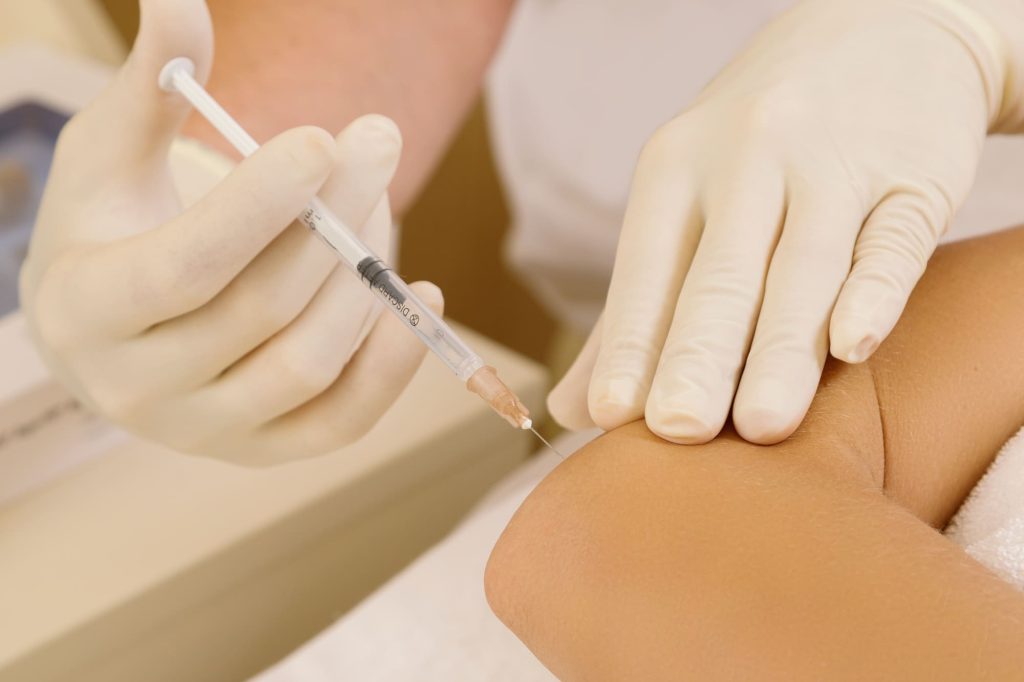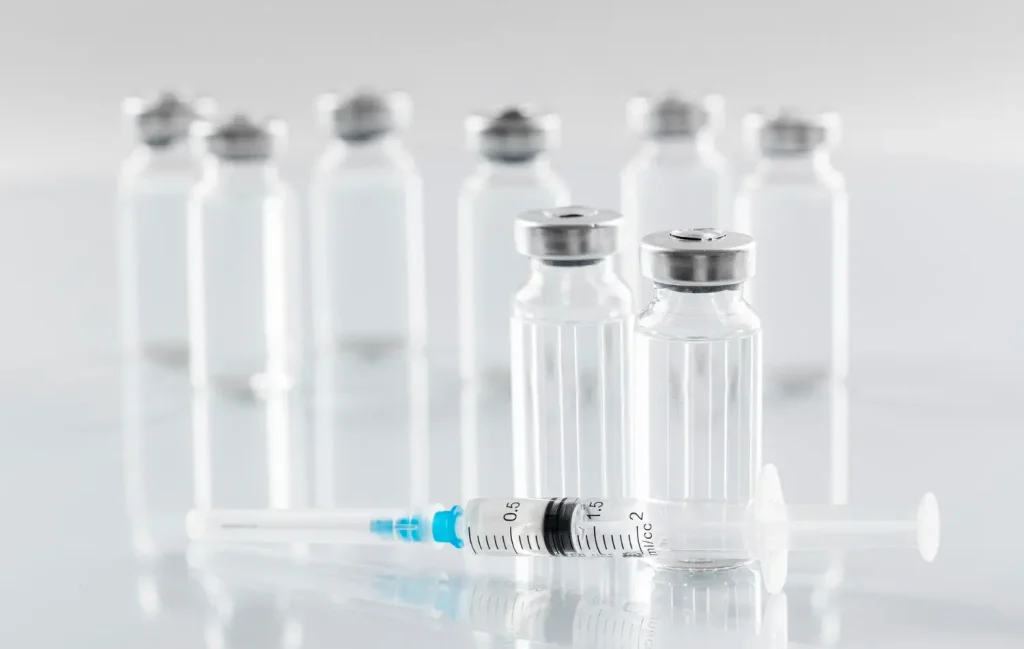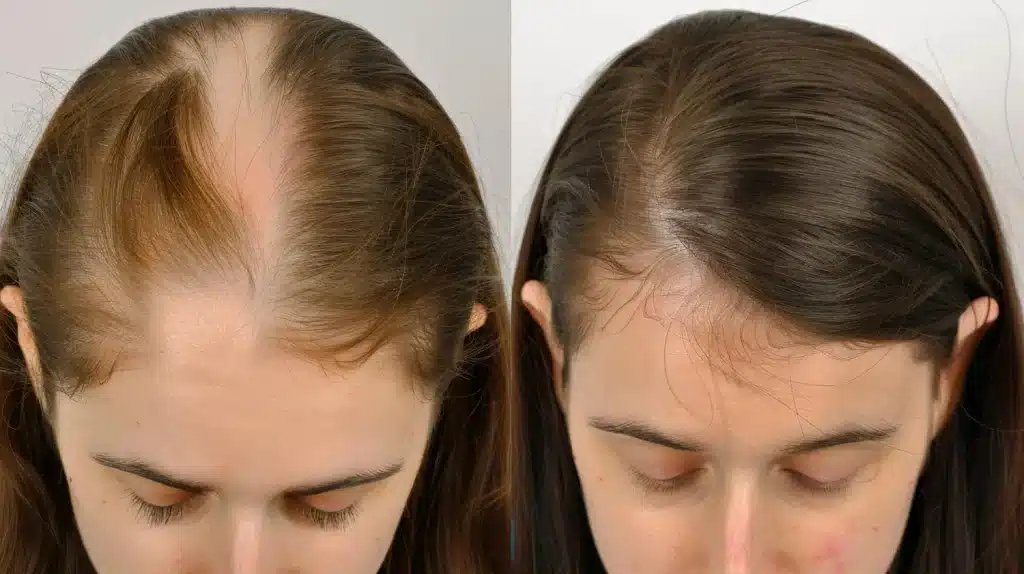Disclaimer
All hyaluronic acid products, including dermal fillers must be injected by a registered medical practitioner to get the best result and avoid uncommon side effects. We discourage any self-usage attempt by patients.
Intro
Hyaluronic acid (HA) is a substance that can be found in mammalian body tissues. In the 1980s, the mass production of synthetic hyaluronic acid began. Hyaluronic acid is widespread in cosmetology because it can remove the signs of aging. However, there are other areas for this substance.
One of the widely used hyaluronic acid treatments is osteoarthritis pain therapy. Hyaluronic acid injection in the knees cannot stop the degradation of the natural tissues, but it can replace the natural lubricant and help the patient reduce pain and return to everyday activities.
Should the Patient Try Hyaluronic Acid Injections in the Knees
Osteoarthritis is a common form of arthritis that affects many joints, including the knees. It is essential to understand that it is impossible to reverse osteoarthritis, so the treatment should focus on pain relief. Without feeling pain, a patient can live an everyday life.
The hyaluronic acid injection in the knees is not the only available treatment. A patient can take a painkiller orally, like ibuprofen. However, many patients do not feel the significant effect of painkilling drugs. In these cases, the injection of hyaluronic acid in the knees can be even more effective than a painkiller.
The effect of the injections shows in several days after injection (or injections, if a treatment requires several procedures) and lasts up to 6 months.
So, if a patient suffers from osteoarthritis and does not feel the effect of a painkilling drug, the therapist can recommend a hyaluronic acid injection in the knees.
Hyaluronic Acid Effect on Knee Joint
Before discussing the hyaluronic acid effect on knee joints, let us refresh the changes in patients with osteoarthritis.
The joint head is covered with articular cartilage, a firm connective tissue, and this tissue is slippery that enables nearly frictionless joint motion. For better mobility, cartilage is covered with synovium, another body tissue type that produces synovial fluid and works as a lubricant in a knee.
Sometimes the joint tissues gradually degrade and change their structure. An articular cartilage and synovium become thinner, the synovial fluid volume decreases, and the parts of a joint start scratching each other when a patient moves. This condition is known as osteoarthritis.
Some risk factors can increase the chance of osteoarthritis in the patient:
- Genetics. A patient with a family history of joint diseases has a higher risk of disease;
- Overweight. An extra load enforces the joint tissue degradation;
- Joint injuries. Sometimes the injury can provoke osteoarthritis development;
- Sex. Studies show that women are more vulnerable to joint tissue degradation:
- Age. Joint tissue degradation is rarely observed in younger patients.
- Metabolic diseases. Diabetes and some other diseases harm the joints.
Unfortunately, it is impossible to reverse joint tissue destruction, but some prescription medications can slow the process down. However, sometimes pain relievers can provide no or minor effect. In this case, patients can try hyaluronic acid injections in the knees.
The main treatment effect of hyaluronic acid is based on its ability to bend water in the body tissues. In knee joints, hyaluronic acid also helps accumulate moisture and add it instead of lacking synovial fluid. The additional lubrication results in less pain for a certain period.
So, hyaluronic acid does not cure osteoarthritis and does not work as a painkiller, but it makes joint movements smoother and less painful.
Types of Active Substances in Viscosupplements
All viscosupplements have hyaluronic acid as the primary active substance. However, three different types allowed for commercial use are different by chemical formula.
Sodium Hyaluronate
Sodium hyaluronate is a sodium salt of hyaluronic acid. This polysaccharide occurs in the body tissues of many mammalians, including humans, but it can be produced artificially. Synthetic sodium hyaluronate is a long-chain polymer of disaccharide units. In the body, it can work as a synovial fluid of a young human.
Hylan GF-20
Hylans are derivatives of sodium hyaluronate of the same formula but different structure. Hylan GF20 is a crosslinked hyaluronan containing Hylan A and Hylan B. Also, the molecular weight of this hyaluronic acid is relatively high. There is no evidence that crosslinked hyaluronan is more effective than other types of hyaluronic acid.
High Molecular Weight Hyaluronan
Recent studies show that synthetic hyaluronic acid molecules of different weights have different effects. Thus, the high-weight molecules (ca. 1000–8000 kDa) have an anti-oncogenic impact together with its main effect of a lubricant. At the same time, smaller weight molecules (<900 kDa) can have a pro-oncogenic impact.
As soon as clinical trials confirmed the anti-oncogenic impact of the high-weight molecules, leading hyaluronic acid producers launched specialized products with high molecular weight hyaluronan. One of these products is Orthovisc. High molecular weight hyaluronan can be more effective as a lubricant also.
Seven Popular Brands of Hyaluronic Acid Injection in 2023
We offer a list of popular hyaluronic acid products for knee treatment. All these products are specialized knee joint injection gels for patients who failed to respond to the classical treatment. A product can be intended for several procedures or as a one-time treatment. Using the website drugs.com, we checked the patient reviews for these drugs.
SYNVISC
Synvisc and SynviscOne® are two products with a single formula. The main difference is that SynviscOne is a one-dose product, while Synvisc is a three-dose product. Almost all similar products have two versions, for one dose and several doses.
Synvisc is a thick gel, like almost all similar products, and it works like synovial fluid as a lubricant and stress absorber. 61% of patients provided positive feedback for this product. Brand Synvisc belongs to the global pharmaceutical company Sanofi-Aventis.
ORTHOVISC
Orthovisc is an American product manufactured and distributed in the USA by the privately-owned Anika company and FDA-approved to treat pain in the knee with osteoarthritis. The producer claims this product contains high molecular weight hyaluronan that is more effective and has an anti-oncogenic impact. There is no evidence that Orthovisc is efficient for patients under 21 years. 53% of reviewers provided positive feedback for this product.
Also read: Orthovisc vs Synvisc.
MONOVISC
Monovisc is another product by the U.S. Anika company. It is a one-injection non-animal hyaluronic acid gel for knee joint treatment. This product is promoted as a super high-quality substance because of no recorded pseudo-inflammation effect after the injection. The reviewers gave 49% positive feedback for Monovisc.
EUFLEXXA
Euflexxa is a very effective osteoarthritis pain treatment product that can relieve a patient for six months. Some patients even report the partial renewal of the articular cartilage though no clinically observed proof exists. Euflexxa is a product of Ferring Pharmaceutical, the US affiliate of the Swiss international company specializing in reproductive medicine and maternal health. 56% of the reviewers noticed the positive effect of this product.
HYALGAN
Hyalgan is another specialized product for knee pain osteoarthritis treatment in a patient who has failed to respond adequately to supporting therapy. Hyalgan is produced in Italy for the US pharmaceutical company Sanofi-Aventis. 44% of the patients reported the positive effect, but no children under 21 and pregnant women were in the focus group.
Also read: Hyalgan vs Synvisc.
DUROLANE
Durolane, originated from Sweden, is a hyaluronic gel for joint injections. This one-injection osteoarthritis pain treatment drug is not approved for other joints. Durolane was not tested on patients below 21 years. The effect of Durolane injection appears in 3-5 days. 32% of patients confirm the positive Durolane impact on their knees.
SUPARTZ
Supartz and Supartz FX are often mistaken for Durolane, but the reason is that all these products are parts of the Swedish brand Bioventus. Supartz is a several-dose treatment, and Supartz FX is for one-dose therapy. Both products are hyaluronic acid gels that smooth joint movements and allow patients to return to their daily activities.
Also read: Orthovisc vs Supartz.
Are Viscosupplements Safe?
Viscosupplements are mostly safe for patients. However, before making injections, consider the product, the injector, and the individual reactions.
Product Safety
Viscosupplements, especially those with exogenous hyaluronic acid, are becoming more and more popular. Unfortunately, that also means a growing number of generic and fake products have appeared on the market. Choosing official distributors is a way to be certain you buy an authentic product. Buying hyaluronic acid for knee joint injection applications, from Medicalsparx.com, an official multi-brand distributor, will ensure product quality and safety.
Certified Injector
A healthcare specialist who makes a knee injection should be trained and certified for this procedure. The hyaluronic acid injection is a low-invasive procedure, but it should be conducted in particular healthcare institutions to avoid an uncontrolled, unsterile environment.
Individual Reaction
When used appropriately, hyaluronic acid is safe. An allergic reaction can occur, but it is rare. However, some categories of patients should be careful with viscosupplements injections. They are the following:
- Patients with a history of severe allergic reactions;
- Patients who take prescription medications at the time of planned injection;
- Patients who receive another form of joints treatment at this time;
- Pregnant and breastfeeding women because the effect of HA remains unknown.
Side Effects and Warnings
The patient can report two types of side effects after viscosupplements injections in knees, typical and rare. Specific side effects after hyaluronic acid injections are the following:
- Local pain at the injection site;
- Joint pain;
- Itchiness, bruising, and redness at the injection site;
- Higher body temperature at the injection site;
- Headache;
- Pain in back.
These side effects do not require additional treatment and disappear in 48 hours. However, if these symptoms do not fade or worsen, the patient should contact a healthcare specialist.
Rare side effects include joint swelling (fluid accommodation), high body temperature, and other flu-like symptoms. While there is a minor infection risk, it is necessary to contact the therapist immediately.
To avoid the consequences, do not consider hyaluronic injections for knees for patients with hypersensitivity to hyaluronic acid, skin diseases at the injection site, prescription medication or other therapy, or pregnant and breastfeeding women.
Conclusion
Osteoarthritis is a widespread disease: in the USA only one in four individuals suffer from some form of arthritis. It means more than 50 million patients, and more than 30 million of them suffer from osteoarthritis. This disease is irreversible, so the therapy focuses on pain relief.
Hyaluronic acid for knees can be more effective than painkilling drugs. Hyaluronic acid replaces the natural synovial fluid in the knee and works as a lubricant and shock absorber. For many patients who do not feel the effect of painkillers, hyaluronic acid reduces pain, and a patient can return to everyday life.
Hyaluronic acid injections in the knees do not provoke significant side effects. The main effect appears 3-5 days after injection and lasts up to six months. So, hyaluronic injections for knees can be recommended for many patients with osteoarthritis. Numerous brands from different countries offer high-quality hyaluronic gel for knee injections.
Only certified specialists can make these injections. We discourage home treatment or self-treatment.
FAQ
How Effective Are Hyaluronic Acid Injections for Osteoarthritis?
Hyaluronic injections for osteoarthritis can reduce pain syndrome for several months due to the additional fluid in the joint. However, it does not treat the disease and does not stop the changes in joint tissues.
Can You Take Viscosupplements While Pregnant or Breastfeeding?
There are no proven cases of the viscosupplements effect on babies in pregnant or breastfeeding mothers. However, there is no proof that hyaluronic acid injection in a mother does not affect a baby, so a woman should make a well thought decision before a procedure.
Can Children Take Hyaluronic Acid Injections?
Hyaluronic acid treatment has been successfully performed in children with several conditions, including knee pain, e.g., after trauma.
Are Viscosupplements Controlled Substances?
No, viscosupplements are not listed as controlled substances in 2023. The situation can change, but now there are reasons to wait for it.
References
Frampton JE. Hylan G-F 20 single-injection formulation. Drugs Aging. 2010 Jan 1;27(1):77-85. Doi: 10.2165/11203900-000000000-00000. PMID: 20030435.
Kikuchi T, Yamada H, Shimmei M. Effect of high molecular weight hyaluronan on cartilage degeneration in a rabbit model of osteoarthritis. Osteoarthritis Cartilage. 1996 Jun;4(2):99-110. doi: 10.1016/s1063-4584(05)80319-x. PMID: 8806112.
Lohse A, Gizard A, Balblanc JC, Conrozier T (2020) Hyaluronic Acid Intra-Articular Injections for Treating Idiopathic Patello-Femoral Chondropathy in Adolescents. Adv Ortho and Sports Med: AOASM-117.
Ooki T, Murata-Kamiya N, Takahashi-Kanemitsu A, Wu W, Hatakeyama M. High-Molecular-Weight Hyaluronan Is a Hippo Pathway Ligand Directing Cell Density-Dependent Growth Inhibition via PAR1b. Dev Cell. 2019 May 20;49(4):590-604.e9. doi: 10.1016/j.devcel.2019.04.018. Epub 2019 May 9. PMID: 31080060.
Torretta S, Marchisio P, Rinaldi V, Gaffuri M, Pascariello C, Drago L, Baggi E, Pignataro L. Topical administration of hyaluronic acid in children with recurrent or chronic middle ear inflammations. Int J Immunopathol Pharmacol. 2016 Sep;29(3):438-42. Doi: 10.1177/0394632016656012. Epub 2016 Jun 24. PMID: 27481884; PMCID: PMC5806751.





















